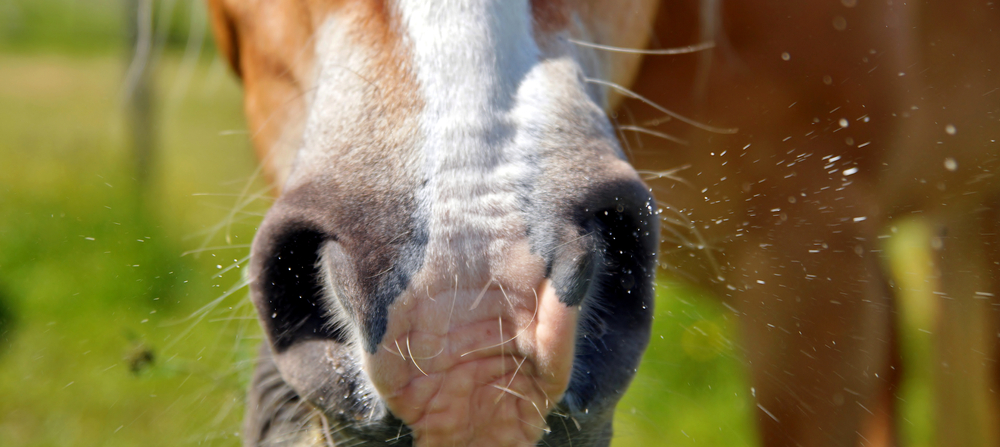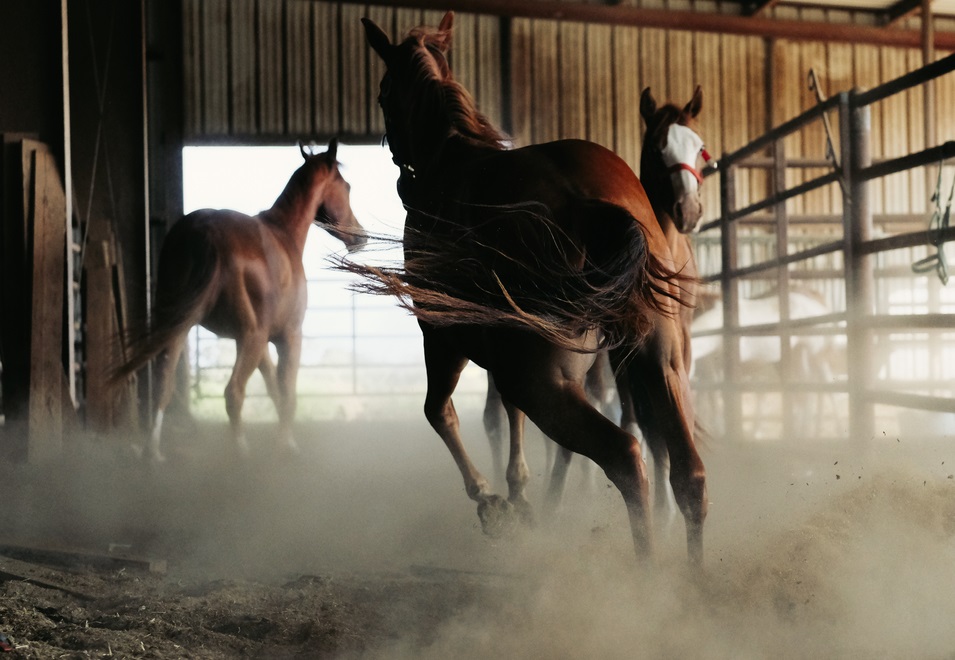Whinny’s Wisdoms

Hey everybody, Whinny here! This week we’re talking about breathing problems in horses. Equine Asthma, which is what we’re calling it now, has been known by several other names over the years. Some of the most commonly used terms were Heaves, Recurrent Airway Obstruction, and Inflammatory Airway Disease.
Equine Asthma is a disease primarily associated with lung inflammation. This lung inflammation results in the clinical signs that we observe with this disease, including coughing, mucous production, wheezing noises from bronchoconstriction, and a “heave line”. The heave line can be observed as an abdominal push near their flank area where they are exerting extra pressure to breathe. This is often accompanied by nostril flaring. As you can imagine, an Equine Asthma attack can be distressing for the horse and hard to witness for someone who is caring for them.

Diagnosing Equine Asthma can be done with a thorough physical exam. My veterinarians will listen to the lungs of a horse with their stethoscope for a high pitched “wheeze” noise. This noise in an otherwise healthy horse that has a cough is often enough to diagnose Equine Asthma. More complex cases may require a BAL (bronchoalveolar lavage) where my doc takes a sample of the lower airway and evaluates it for the presence of certain types of cells to confirm the diagnosis.
Equine Asthma is often triggered by different allergens. The biggest culprit for horses tends to be dust. Additionally, mold, pollen and other environmental allergens can play a role in triggering an acute asthma attack. Asthma often occurs seasonally, but some horses do need to be treated year round.
Whinny Wisdom: Donkeys are just as susceptible to Equine Asthma as horses are! Make sure you keep an eye on their breathing, and be ready to manage them and their environment the same way you would with your horse.
Since there is inflammation in the lungs with Equine Asthma, the mainstay of therapy includes a very potent anti-inflammatory: dexamethasone. This is a steroid medication that can be given orally, intravenously or intramuscularly. Since we are often giving this medication daily, many owners prefer to give the medication orally (the horses also prefer this way). The biggest risk to steroid medications is laminitis or founder. Due to this risk, nebulized or inhaled versions of steroids may alternatively be used instead of dexamethasone to treat the condition. This may be recommended based on an individual horse’s concurrent risk factors for laminitis. Yet another good reason to keep your horse at a healthy weight!
In an Equine Asthma attack, a rescue medication may be used for several days in a row to help open the lower airways in addition to the steroid therapy to reduce inflammation. This rescue drug is commonly called Ventipulmen, or clenbuterol. This medication may be recommended to have on hand depending on the horse’s response to steroids.
Additionally, an antihistamine such as ceterizine (generic form of Zyrtec) or hydroxyzine may help reduce the number of acute episodes a horse may experience depending on the allergens that are causing the asthma in the patient. While these medications can help reduce the number of episodes, they do not provide the anti-inflammatory effects that a steroid can provide, so cannot be solely used for management. (If you read between the lines, it says: don’t do any of this without the guidance of your veterinarian!)

Finally, a key management factor is environmental management. This primarily focuses on reducing dust since this is often one of the main triggers for Equine Asthma. This can be accomplished by wetting any feed, both grain and hay. In more severe cases, some horses may not be able to consume hay due to the dust and allergens that are present. Hay steamers can also help in these situations as they reduce dust and kill mold spores and bacteria that may be present. Depending on the horse’s allergens, stabling time may need to be limited as the barn bedding can be dusty. If a horse with Asthma needs to be stalled, minimally dusty bedding such as hemp or flax should be selected. Straw should not be used as it often has a high level of dust and allergens.
Although it can be stressful to see your horse afflicted by Equine Asthma, it’s important to remember that treatment options are available to manage this condition and my docs here at Springhill Equine are ready to help. If you think your horse might be developing a breathing problem, give us a call at (352) 472-1620 to set up an evaluation.
Until next week,
~Whinny
P.S. Want more? Check out the podcast episode my docs did on airway issues in horses! You can listen to it right from your phone, and by the end you’ll know all about it!
 Whinny’s Wisdoms is the official blog of Whinny the Clinic Mouse at Springhill Equine Veterinary Clinic in Newberry, Florida. If you liked this blog, please subscribe below, and share it with your friends on social media! For more information, please call us at (352) 472-1620, visit our website at SpringhillEquine.com, or follow us on Facebook!
Whinny’s Wisdoms is the official blog of Whinny the Clinic Mouse at Springhill Equine Veterinary Clinic in Newberry, Florida. If you liked this blog, please subscribe below, and share it with your friends on social media! For more information, please call us at (352) 472-1620, visit our website at SpringhillEquine.com, or follow us on Facebook!
[jetpack_subscription_form title="Subscribe to Whinny's Wisdoms"]

